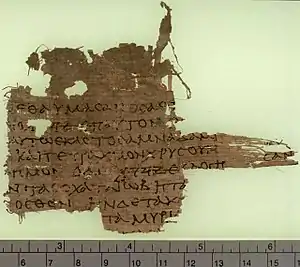Papyrus Oxyrhynchus 3522
The Papyrus LXX Oxyrhynchus 3522, (signed as P.Oxy.L 3522: Rahlfs 857) – is a small fragment of the Greek Septuaginta (LXX) written in papyrus, in scroll form. As one of the manuscripts discovered at Oxyrhynchus it has been catalogued with the number 3522. Palaeographically it has been dated to the 1st century CE. The text agrees with the LXX.[1]

Description
This fragment contains Job 42,11-12.[2]
Version
P. J. Parson claim that its text "stands closer to the LXX rather than the literal accurate version of Symmachus the Ebionite.[1][3]
Tetragrammaton
This manuscript includes the tetragrammaton (written from right to left) in paleo-Hebrew.[2][4][5]
Text
Text according to A. R. Meyer:
κ]αι εθαυμασαν οσα επ[ηγα
γε]ν ο 𐤉𐤄𐤅𐤄 επαυτον εδ[ωκε
δε ]αυτω εκαστος αμναδα μι
αν] και τετραχμον χρυσουν
α]σημον ο δε 𐤉𐤄𐤅𐤄 ευλογη
σ]εν τα εσχατα ϊωβ η τα [εμ
π]ροσθεν ην δε τα κτ[ηνη
αυτου προβα]τα μυρια[ τε [6]: 232
Romanization of Meyer:
k]ai ethaumasan osa ep[ēga
ge]n ho 𐤉𐤄𐤅𐤄 epauton ed[ōke
de ]autō ekastos amnada mi
an] kai tetrachmon chrysoun
a]sēmon ho de 𐤉𐤄𐤅𐤄 eulogē
s]en ta eschata Ïōb hē ta [em
p]rosthen ēn de ta kt[ēnē
autou proba]ta myria[ te
NIV translation:
They comforted and consoled him over all the
trouble the LORD had brought on him,
and each one gave him
a piece of silver and a gold ring.
The LORD blessed
the latter part of Job’s life
more than the former part.
He had [fourteen] thousand sheep…[7]
History
The fragment was published in 1983 by P. J. Parsons in The Oxyrhynchus Papyri, vol. L (50). Also the fragment is catalogued with number 857 in the list of manuscripts of the Septuagint as the classification of Alfred Rahlfs, also as LDAB 3079.[8]
Location
The manuscript is kept in the Papyrology department of the Sackler library in Oxford as (P.Oxy.L 3522).
References
- Alison G. Salvesen; Timothy Michael Law, eds. (2021). The Oxford Handbook of the Septuagint. Oxford Handbooks. Oxford University Press. ISBN 9780191644009.
- Emanuel Tov (2001). Uitgeverij Van Gorcum (ed.). Textual Criticism of the Hebrew Bible. Minneapolis: Fortress Press; Assen: Royal Van Gorcum. p. 220. ISBN 0-8006-3429-2.
- Michael P. Theophilos. Recently Discovered Greek Papyri and Parchment of the Psalter from the Oxford Oxyrhynchus Manuscripts: Implications for Scribal Practice and Textual Transmission Archived 2019-03-14 at the Wayback Machine. Australian Catholic University.
- Alan K. Bowman (1983). The Oxyrhynchus Papyri, Part L. London: The British Academy & The Egypt Exploration Fund. pp. 1–3.
- Philip Wesley Comfort (2005). Encountering the Manuscripts: An Introduction to New Testament Paleography & Textual Criticism. B&H Publishing Group. p. 208. ISBN 9780805431452.
- Anthony R. Meyer, The Divine Name in Early Judaism: Use and Non-Use in Aramaic, Hebrew, and Greek (McMaster University, 2017)
- "Bible Gateway Job 42 :: NIV". web.mit.edu.
- Larry W. Hurtado (2006). The Earliest Christian Artifacts: Manuscripts and Christian Origins. Sheffield: Wm. B. Eerdmans Publishing Co. p. 213. ISBN 0-8028-2895-7.
Bibliography
- P. J. Parsons. "P.Oxy.L 3522". Oxyrhynchus Online. The Oxyrhynchus Papyri vol. L. Retrieved April 21, 2012.
External links
- Picture of P. LXX Oxyrhynchus 3522 Archived 2014-08-12 at the Wayback Machine